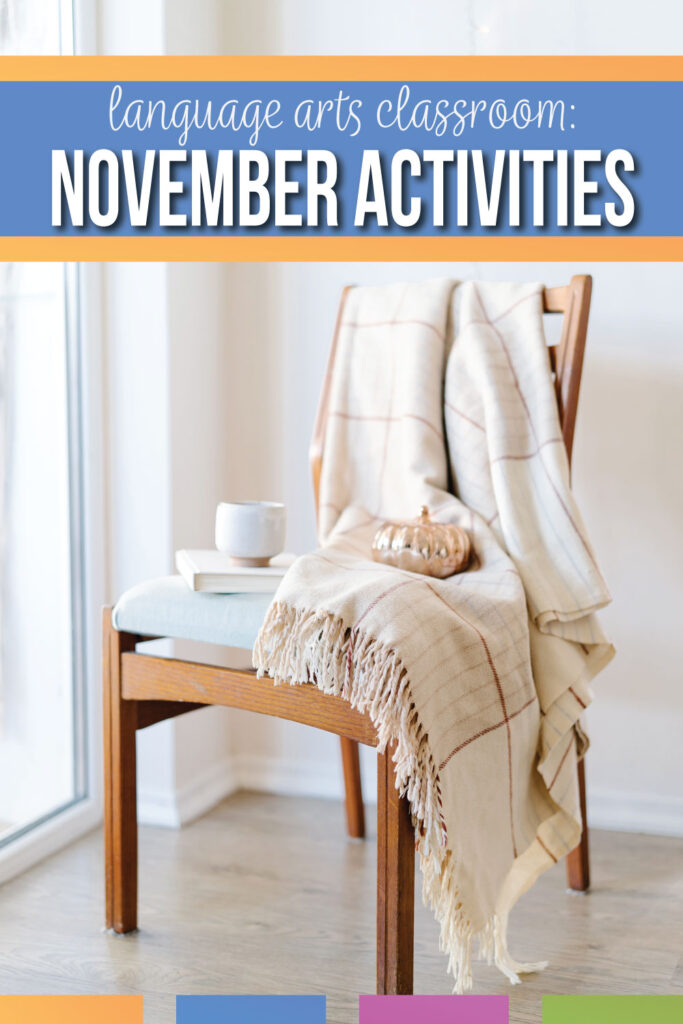November language arts lessons: As English classes head toward the end of the first semester, keep students engaged and reflect on your classes.
November is here, and (many) schools have closed the first quarter in the USA. The calendar break allows teachers to segue with changes in the classroom; the change into second quarter is a time for a quick teacher reflection.
Why? Well, enough of the school year has passed that you can fairly evaluate what is working and what needs changed. Students know you well enough that they you provide feedback about lessons and procedures. You can gauge what certain classes need more of (reading time? grammar practice?), and methods that work for teaching them.
Plus, it is the end of a something. You can say, “starting this quarter, we will try…” and you’ve created a natural flow.
The end of the first quarter is a perfect time to reflect on certain areas. Here are a few.

Assess your teaching, guilt-free.
Don’t beat yourself up, but look at what is going well, and what could go better. Give yourself a pat on the back for your strong points… because teaching is hard.
Also check what could change. For instance, students can pick up on tiny nonverbal communication. If a class really gets under your skin, you may inadvertently worsen the situation by revealing dread. If you don’t care for a certain subject, ensure you are teaching it the best you can. (For ways I teach poetry—not a favorite of mine!— read this.)
Evaluate particular activities.
If students do poorly with textbook exercises, perhaps switch to task cards. When one class struggles to take notes, look into note outline sheets. Are students struggling with conclusion? Implement student choice with graphic organizers. You needn’t completely overhaul your classroom; however, I find that providing new learning opportunities helps.
Dependent upon the type of grade-book you have, you may be able to sort out the “types” of grades for classes. What areas are students succeeding? floundering? This natural break into the second quarter works perfectly to try a new tool or to find more of a successful one. Some grade-books allow for a look at each standard. Is a particular standard needing more attention?
Say you want to try interactive notebooks, but you’re not sure that classes will use them thoroughly, that classes will dive into them. Tell students you are running an experiment this quarter. Will interactive notebooks create more meaning for students? With older students, you can let them in on your plan. Try a different approach for nine weeks. Explain that one area has fallen behind (such as note taking), and this (insert your idea) is a fix. I love that with older students, teachers can include them in the planning.
Look at your work-life balance.
(This may sound cliche, but it’s true—you can’t work all the time.) Teaching is a weird profession in that people believe you should pack papers for home every night. From someone who once thought that and who once graded and planned and created every night, you cannot do that. November language arts lessons must include a reflection from the teacher. . . concerning the teacher’s health.
You should complete an enjoyable activity on the weekends, if not more time. Complete a scrapbooking page every weekend; play cards with friends. Your health matters too. Take a walk, take a class, take a “something” that gets your heart pumping.
Ask for help.
You may need more teaching materials, or different materials, or advice for creating materials. Asking a coworker who knows your exact situation is best, but online groups will support you too. When I complete a teacher reflection, I soon find myself in a coworker’s classroom, asking for advice and tips.
Show initiative and talk to other teachers. Asking for help in the teaching profession is a strength.
You might find that a small tweak will help. At the end of the first quarter, if students don’t follow a certain procedure or understand a specific (frequently taught!) concept, look at why. Do students understand the reasoning behind it? Do you provide materials and structure for students to complete the procedure or lesson? Evaluate what is lacking. You might need to clarify your rules and procedures.
Review creatively.
Typically by November, students and I have completed a variety of writing and grammar activities. Before we head into new concepts, I review with students. For some reason, November has a variety of half days and special meeting days. (Maybe only in Illinois?) Anyway, I find that review helps to connect previous ideas to the new ones.
My favorite grammar review includes coloring, specifically fall grammar coloring activities. Not only do students practice an area they need to practice, but they also have fun and decorate the classroom.
Any review activity for short days or days before break works!
Provide a message.
Are you providing a large direction for students? Older students appreciate knowing that their learning has a bigger picture. My overall message to students is that they are life-long learners and readers.
A reboot may be in order. Now that November has arrived, students should be in a rhythm and relationships between you and your students should be growing. If an area needs a boost, look at your November language arts lessons, your health, and you classroom community.
November is the perfect time to do so.
Not quite ready for November? Read my October language arts activities. Planning ahead? Try December language arts activities.
Why is a post about November English lessons filed under “classroom management”? Well, I believe when we ELA teachers show students we get “it”—that they are excited about factors outside our classroom—our relationships improve, and thus, classroom management is less of an issue.

